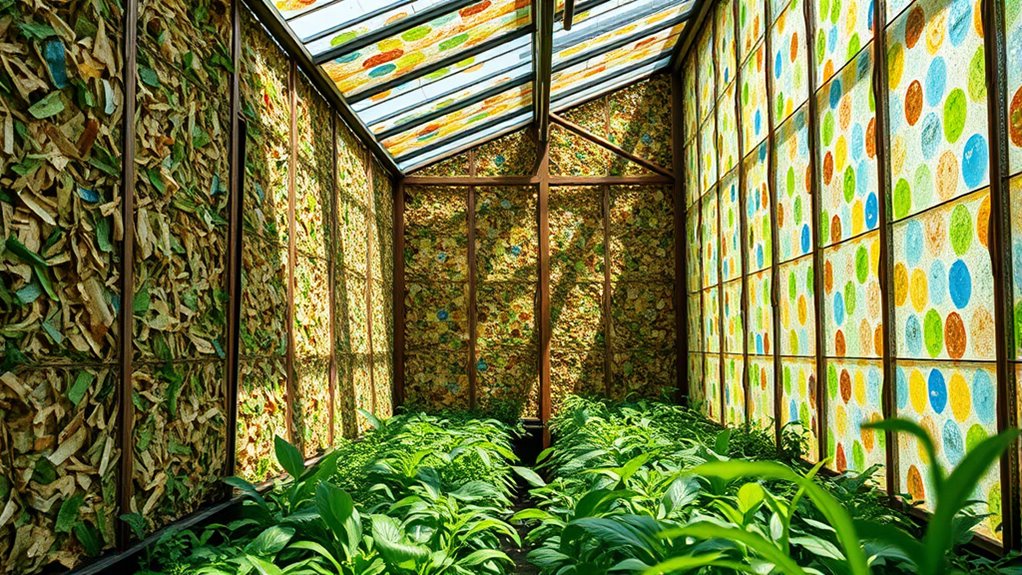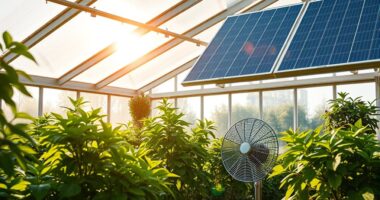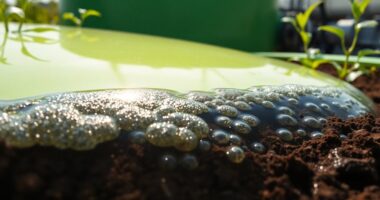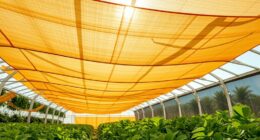Using recycled materials to insulate your greenhouse is an eco-friendly way to boost thermal efficiency and save on energy costs. Materials like plastic bottles, foam, newspapers, or cardboard help retain heat, reduce drafts, and make your space more stable for plants. Proper installation guarantees minimal gaps and leaks for maximum benefit. If you want to discover more tips on effective insulation with recycled materials, keep exploring these sustainable solutions.
Key Takeaways
- Using recycled materials like plastic bottles and foam enhances greenhouse insulation while supporting sustainability.
- Proper installation of recycled materials improves thermal efficiency and minimizes heat loss during colder months.
- Incorporating recycled materials into walls, floors, or roofs creates a cost-effective and eco-friendly insulation solution.
- Better insulation with recycled materials reduces energy costs by decreasing reliance on heating systems.
- Recycling waste into greenhouse insulation lowers environmental impact and promotes eco-conscious gardening practices.

Are you looking to extend your growing season and protect your plants from harsh weather? Insulating your greenhouse is essential, and using recycled materials can be a smart, eco-friendly choice. When you focus on thermal efficiency, you improve how well your greenhouse retains heat, which is critical during cold months. Recycled materials like old plastic bottles, used insulation panels, or repurposed foam can be effectively integrated into your greenhouse walls and roof to prevent heat loss. These materials often have excellent insulating properties, helping you maintain a stable temperature inside, even when outdoor conditions are challenging. By choosing recycled options, you’re also supporting material sustainability, reducing waste, and lowering your overall environmental impact.
Thermal efficiency is the cornerstone of effective greenhouse insulation. When you install recycled insulation, you’re giving your plants a more consistent environment, which promotes healthier growth. For example, shredded plastic bottles can be layered within walls or underneath flooring to act as a barrier against cold drafts. Old foam panels, when properly sealed, can trap heat and prevent it from escaping through gaps or cracks. The key is ensuring your recycled materials are installed correctly, with minimal air leaks, to maximize their insulating capabilities. This approach doesn’t just save energy; it also reduces your heating costs, making your greenhouse more economical to operate. Plus, using recycled materials often means you’re working with lighter, easier-to-handle options, simplifying installation. Incorporating thermal properties of recycled materials can further enhance insulation effectiveness.
Material sustainability plays a significant role in making your greenhouse more eco-friendly. When you repurpose waste materials, you’re giving them a second life and cutting down on the demand for new resources. This not only conserves raw materials but also minimizes landfill waste. For instance, old newspapers or cardboard can be layered as insulating barriers, provided they’re treated to resist moisture. Similarly, repurposed plastic bottles or containers can be molded into insulating panels or barriers. These sustainable choices align with eco-conscious gardening practices and demonstrate your commitment to environmental responsibility. Additionally, many recycled materials are readily available and affordable, making it easier for you to implement insulation without breaking the bank. By prioritizing material sustainability, you’re helping reduce your carbon footprint while creating a healthier environment for your plants.
Frequently Asked Questions
How Do Recycled Materials Compare Cost-Wise to Traditional Insulation?
Recycled materials often cost less than traditional insulation, offering a favorable cost comparison. They typically come from waste products, reducing raw material expenses. Plus, many recycled options, like recycled denim or cellulose, are durable and maintain their insulating properties over time. You’ll find that choosing recycled insulation can save you money upfront and provide long-lasting durability, making it a smart, eco-friendly investment for your greenhouse.
Are There Any Health Risks Associated With Recycled Insulation Materials?
Think of recycled insulation like a garden’s compost—generally safe if handled properly. While chemical safety is maintained through strict regulations, allergen concerns can arise if you’re sensitive to dust or fibers. I once worked with recycled denim insulation, and with proper ventilation, I didn’t experience issues. Overall, these materials are designed to be safe, but always wear protective gear during installation to minimize risks.
How Long Does Recycled Insulation Typically Last in a Greenhouse?
Recycled insulation typically lasts 10 to 20 years in a greenhouse, depending on the material quality and installation. You can expect good insulation durability and material longevity if you choose high-quality recycled products. Regular inspections will help you identify wear or damage early, ensuring your greenhouse stays well-insulated. Proper maintenance and choosing durable recycled materials can extend the lifespan, keeping your greenhouse energy-efficient and protected for years to come.
Can Recycled Insulation Improve Energy Efficiency in All Climates?
Think of recycled insulation as a chameleon, adapting to various environments. It can boost energy efficiency across many climates by enhancing insulation performance and maintaining stable temperatures. While it’s not a magic bullet for every scenario, its versatility supports climate adaptability. You’ll find it helps keep your greenhouse warmer in winter and cooler in summer, making it a smart, eco-friendly choice to optimize energy use wherever you are.
What Environmental Benefits Do Recycled Insulation Materials Provide?
Recycled insulation materials help reduce your environmental impact by lowering the carbon footprint associated with manufacturing new products. They promote waste reduction by repurposing old materials instead of sending them to landfills. Using recycled insulation conserves natural resources, decreases energy consumption during production, and minimizes pollution. By choosing these eco-friendly options, you actively contribute to a healthier planet while maintaining effective insulation for your greenhouse.
Conclusion
By choosing recycled materials for your greenhouse insulation, you’re not only saving money but also helping the environment. Did you know that using recycled insulation can reduce waste by up to 30%? This eco-friendly approach keeps your greenhouse warmer in winter and cooler in summer, boosting plant growth year-round. So, make a smart, sustainable choice—insulate with recycled materials and contribute to a healthier planet while nurturing your garden.








